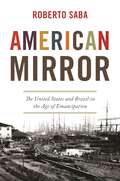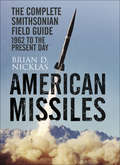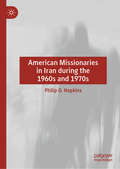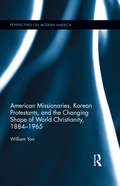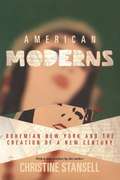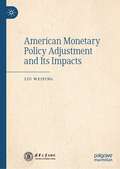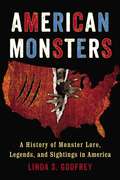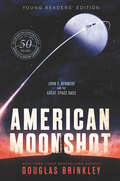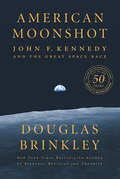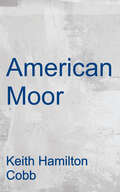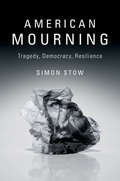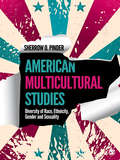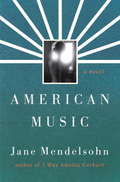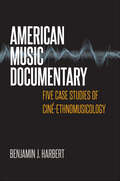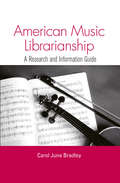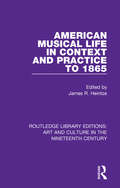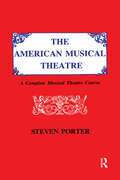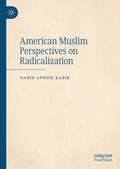- Table View
- List View
American Mirror: The United States and Brazil in the Age of Emancipation (America in the World #58)
by Roberto SabaHow slave emancipation transformed capitalism in the United States and BrazilIn the nineteenth century, the United States and Brazil were the largest slave societies in the Western world. The former enslaved approximately four million people, the latter nearly two million. Slavery was integral to the production of agricultural commodities for the global market, and governing elites feared the system’s demise would ruin their countries. Yet, when slavery ended in the United States and Brazil, in 1865 and 1888 respectively, what resulted was immediate and continuous economic progress. In American Mirror, Roberto Saba investigates how American and Brazilian reformers worked together to ensure that slave emancipation would advance the interests of capital.Saba explores the methods through which antislavery reformers fostered capitalist development in a transnational context. From the 1850s to the 1880s, this coalition of Americans and Brazilians—which included diplomats, engineers, entrepreneurs, journalists, merchants, missionaries, planters, politicians, scientists, and students, among others—consolidated wage labor as the dominant production system in their countries. These reformers were not romantic humanitarians, but cosmopolitan modernizers who worked together to promote labor-saving machinery, new transportation technology, scientific management, and technical education. They successfully used such innovations to improve production and increase trade.Challenging commonly held ideas about slavery and its demise in the Western Hemisphere, American Mirror illustrates the crucial role of slave emancipation in the making of capitalism.
American Misfits and the Making of Middle-Class Respectability
by Robert WuthnowHow American respectability has been built by maligning those who don't make the gradeHow did Americans come to think of themselves as respectable members of the middle class? Was it just by earning a decent living? Or did it require something more? And if it did, what can we learn that may still apply?The quest for middle-class respectability in nineteenth-century America is usually described as a process of inculcating positive values such as honesty, hard work, independence, and cultural refinement. But clergy, educators, and community leaders also defined respectability negatively, by maligning individuals and groups—“misfits”—who deviated from accepted norms.Robert Wuthnow argues that respectability is constructed by “othering” people who do not fit into easily recognizable, socially approved categories. He demonstrates this through an in-depth examination of a wide variety of individuals and groups that became objects of derision. We meet a disabled Civil War veteran who worked as a huckster on the edges of the frontier, the wife of a lunatic who raised her family while her husband was institutionalized, an immigrant religious community accused of sedition, and a wealthy scion charged with profiteering.Unlike respected Americans who marched confidently toward worldly and heavenly success, such misfits were usually ignored in paeans about the nation. But they played an important part in the cultural work that made America, and their story is essential for understanding the “othering” that remains so much a part of American culture and politics today.
American Missiles: The Complete Smithsonian Field Guide
by Brian D. NicklasThis remarkable guide provides for the first time an illustrated listing of almost 200 of Americas most powerful missiles. With information on all aspects of the missiles specifications, including the speed and capacity of the explosives used in its warhead, this book provides a comprehensive guide to the US Armys projectile hardware. 'American Missiles: The Complete Smithsonian Field Guide' draws heavily on the Herbert S. Desind Photo Collection, a resource of more than 110,000 images recently catalogued at the National Air and Space Museum. Of interest to both the specialist and the aviation enthusiasts, this book demonstrates the evolution of American missile design over the last forty years in an accessible and entertaining format.
American Missionaries in Iran during the 1960s and 1970s
by Philip O. HopkinsThis work explores the interaction of American Protestant missionaries with Iranians during the 1960s and 1970s. It focuses on the missionary activities of four American Protestant groups: Presbyterians, Assemblies of God, International Missions, and Southern Baptists. It argues that American missionaries’ predisposition toward their own culture confused their message of the gospel and added to the negative perception of Christianity among Iranians. This bias was seen primarily in the American missionaries’ desire to modernize Iran through education and healthcare, and between the missionaries’ relationship with Iranian Christians. Iranian attitudes towards missionary involvement in these areas are investigated, as is the changing American missionary strategy from a traditional method where missionaries had the final say on most matters related to American and Iranian Christian interaction, to the beginnings of an indigenous system where a partnership developed between the missionary and the Iranian Christian.
American Missionaries, Korean Protestants, and the Changing Shape of World Christianity, 1884-1965 (Perspectives on Modern America)
by William YooThis book examines the partnerships and power struggles between American missionaries and Korean Protestant leaders in both nations from the late 19th century to the aftermath of the Korean War. Yoo analyzes American and Korean sources, including a plethora of unpublished archival materials, to uncover the complicated histories of cooperation and contestation behind the evolving relationships between Americans and Koreans at the same time the majority of the world Christian population shifted from the Global North to the Global South. American and Korean Protestants cultivated deep bonds with one another, but they also clashed over essential matters of ecclesial authority, cultural difference, geopolitics, and women’s leadership. This multifaceted approach – incorporating the perspectives of missionaries, migrants, ministers, diplomats, and interracial couples – casts new light on American and Korean Christianities and captures American and Korean Protestants mutually engaged in a global movement that helped give birth to new Christian traditions in Korea, created new transnational religious and humanitarian partnerships such as the World Vision organization, and transformed global Christian traditions ranging from Pentecostalism to Presbyterianism.
American Modern
by Thomas Obrien“One of those designers whose interior and furniture designs look discovered, not created . . . both comfortable and exquisite, calm and eclectic.” —Apartment TherapyDesigner and merchant, collector and tastemaker, Thomas O’Brien has made a career of translating cool notions of modernism into an easy and generous array of modern styles that anyone can attain. Now he introduces readers to a range of those styles—from casual to formal, vintage to urban—alongside stunning photography and charming design stories.O’Brien carefully describes the design process of his chosen projects, including a downtown New York City loft, a traditional Connecticut estate, and a converted schoolhouse in eastern Long Island. Each home explores a view on the modern design spectrum he has created, as well as the individual choices that make the design unique and its mix essentially American. He explains not only what was at work to create a given style, but how readers can import those practices to their own homes and personal design sensibilities. Important design principles such as architectural authenticity, color relationships, correctness of scale, and informed collecting are threaded through a practical narrative that reads like a master class in interior design. American Modern is an inspiring design volume that will redefine the way readers think about modern interiors.“O’Brien carefully describes the design process of his chosen projects. Beautiful imagery and a unique layout describe his approach to design in a new and innovative way.” —LIFEMSTYLE“It’s like getting a glimpse into the studio paintings of a great master . . . I especially love how all of his spaces feel so gender neutral, the perfect balance.” —Cottage Farm
American Modernist Poetry and the Chinese Encounter
by Zhang Yuejun Stuart ChristieAmerican Modernist Poetry and the Chinese Encounteroffers a framework for understanding the variety of imagined encounters by eight different American poets with their imagined 'Chinese' subject. The method is historical and materialist, insofar as the contributors to the volume read the claims of specific poems alongside the actual and tumultuous changes China faced between 1911 and 1979. Even where specific poems are found to be erroneous, the contributors to the volume suggest that each of the poets attempted to engage their 'Chinese' subject with a degree of commitment that presaged imaginatively China's subsequent dominance. The poems stand as unique artifacts, via proxy and in the English language, for the rise of China in the American imagination. The audience of the volume is international, including the growing number of scholars and graduate students in Chinese universities working on American literature and comparative cultural studies, as well as already established commentators and students in the west.
American Moderns: Bohemian New York and the Creation of a New Century
by Christine StansellIn the early twentieth century, an exuberant brand of gifted men and women moved to New York City, not to get rich but to participate in a cultural revolution. For them, the city's immigrant neighborhoods--home to art, poetry, cafes, and cabarets in the European tradition--provided a place where the fancies and forms of a new America could be tested. Some called themselves Bohemians, some members of the avant-garde, but all took pleasure in the exotic, new, and forbidden. In American Moderns, Christine Stansell tells the story of the most famous of these neighborhoods, Greenwich Village, which--thanks to cultural icons such as Eugene O'Neill, Isadora Duncan, and Emma Goldman--became a symbol of social and intellectual freedom. Stansell eloquently explains how the mixing of old and new worlds, politics and art, and radicalism and commerce so characteristic of New York shaped the modern American urban scene. American Moderns is both an examination and a celebration of a way of life that's been nearly forgotten.
American Monetary Policy Adjustment and Its Impacts
by Liu WeipingThis book reviews the historical evolution of U.S. monetary policy, and then uses various methods such as mathematical models and econometric analysis to study the impact of U.S. monetary policy adjustments on the domestic economy and the spillover effects on the world economy. Finally, it summarizes the challenges faced by the Chinese economy in the post financial crisis era and proposes relevant countermeasures and suggestions for China to respond to U.S. monetary policy adjustments.
American Monsters: A History of Monster Lore, Legends, and Sightings in America
by Linda S. GodfreyFrom pre-Columbian legends to modern-day eyewitness accounts, this comprehensive guide covers the history, sightings and lore surrounding the most mysterious monsters in America--including Bigfoot, the Jersey Devil, and more. Bigfoot, the chupacabra, and thunderbirds aren't just figments of our overactive imaginations--according to thousands of eyewitnesses, they exist, in every corner of the United States. Throughout America's history, shocked onlookers have seen unbelievable creatures of every stripe--from sea serpents to apelike beings, giant bats to monkeymen--in every region. Author, investigator, and creature expert Linda S. Godfrey brings the same fearless reporting she lent to Real Wolfmen to this essential guide, using historical record, present-day news reports, and eyewitness interviews to examine this hidden menagerie of America's homegrown beasts.
American Moonshot Young Readers' Edition: John F. Kennedy and the Great Space Race
by Douglas BrinkleyIn anticipation of the 50th anniversary of the first moon landing, New York Times bestselling author and historian Douglas Brinkley delivers a young readers’ edition of a story rooted in heroism, bravery, and patriotism: America’s race to the moon. July 20, 1969. It’s a day that has earned a spot in history. It’s the day that America was the first nation to succeed in sending two astronauts—Buzz Aldrin and Neil Armstrong—to the moon.But what led to this unforgettable event? What were the stakes riding on the Apollo 11’s safe landing? In acclaimed author Douglas Brinkley’s first young readers' edition, space fans will get the riveting and factual backstory of arguably the most significant achievement of the 20th century.
American Moonshot: John F. Kennedy and the Great Space Race
by Douglas BrinkleyAs the fiftieth anniversary of the first lunar landing approaches, the award winning historian and perennial New York Times bestselling author takes a fresh look at the space program, President John F. Kennedy’s inspiring challenge, and America’s race to the moon. <P><P>“We choose to go to the Moon in this decade and do the other things, not because they are easy, but because they are hard; because that goal will serve to organize and measure the best of our energies and skills, because that challenge is one that we are willing to accept, one we are unwilling to postpone, and one we intend to win.”—President John F. Kennedy <P><P>On May 25, 1961, JFK made an astonishing announcement: his goal of putting a man on the moon by the end of the decade. In this engrossing, fast-paced epic, Douglas Brinkley returns to the 1960s to recreate one of the most exciting and ambitious achievements in the history of humankind. <P><P>American Moonshot brings together the extraordinary political, cultural, and scientific factors that fueled the birth and development of NASA and the Mercury, Gemini and Apollo projects, which shot the United States to victory in the space race against the Soviet Union at the height of the Cold War. <P><P>Drawing on new primary source material and major interviews with many of the surviving figures who were key to America’s success, Brinkley brings this fascinating history to life as never before. <P><P>American Moonshot is a portrait of the brilliant men and women who made this giant leap possible, the technology that enabled us to propel men beyond earth’s orbit to the moon and return them safely, and the geopolitical tensions that spurred Kennedy to commit himself fully to this audacious dream. <P><P>Brinkley’s ensemble cast of New Frontier characters include rocketeer Wernher von Braun, astronaut John Glenn and space booster Lyndon Johnson. <P><P>A vivid and enthralling chronicle of one of the most thrilling, hopeful, and turbulent eras in the nation’s history, American Moonshot is an homage to scientific ingenuity, human curiosity, and the boundless American spirit. <P><b>A New York Times Bestseller</b>
American Moor (Modern Plays Series)
by Keith Hamilton CobbKeith Hamilton Cobb embarks on a poetic exploration that examines the experience and perspective of black men in America through the metaphor of Shakespeare's character Othello, offering up a host of insights that are by turns introspective and indicting, difficult and deeply moving. American Moor is a play about race in America, but it is also a play about who gets to make art, who gets to play Shakespeare, about whose lives and perspectives matter, about actors and acting, and about the nature of unadulterated love.
American Mourning: Tragedy, Democracy, Resilience
by Simon StowHow does the way in which a democratic polity mourn its losses shape its political outcomes? How might it shape those outcomes? American Mourning: Tragedy, Democracy, Resilience answers these questions with a critical study of American public mourning. Employing mourning as a lens through which to view the shortcomings of American democracy, it offers an argument for a tragic, complex, and critical mode of mourning that it contrasts with the nationalist, romantic, and nostalgic responses to loss that currently dominate and damage the polity. Offering new readings of key texts in Ancient political thought and American political history, it engages debates central to contemporary democratic theory concerned with agonism, acknowledgment, hope, humanism, patriotism, and political resilience. The book outlines new ways of thinking about and responding to terrorism, racial conflict, and the problems of democratic military return.
American Multicultural Studies: Diversity of Race, Ethnicity, Gender and Sexuality
by Sherrow O. PinderAmerican Multicultural Studies: Diversity of Race, Ethnicity, Gender and Sexuality provides an interdisciplinary view of multicultural studies in the United States, addressing a wide range of topics that continue to define and shape this area of study. Through this collection of essays Sherrow Pinder responds to the need to open up a rich avenue for addressing current and continuing issues of race, gender, ethnicity, sexuality, cultural diversity, and education in their varied forms. Substantial thematic overlaps are found between sections and essays, all of which are oriented toward a single broad objective: to develop new and different ways of addressing how multicultural issues, in their discursive sociocultural contexts, are inextricably linked to the operations of power. Power, as a site of resistance to which it invariably gives rise, is tacked from a perspective that attends to the complexities of America's history and politics.
American Murder
by Mike MayoInvestigating the way Hollywood scoops up notorious criminals and turns them into legends, this entertaining who's-who guide provides thumbnail sketches of such killers as Ma Barker, Black Beard, Al Capone, John Wesley Hardin, and Charles Starkweather. Noting that some figures are glamorized in popular culture (Jesse James), while others are demonized (Charles Manson), this encyclopedic collection explores the legends' emotional truths as depicted in movies, stories, and songs. Facts of the real cases behind these notorious criminals are also presented, including the landmark rulings that pioneered new approaches to criminal justice.
American Murder Houses
by Steve LehtoThere are places in the United States of America where violent acts of bloodshed have occurred.Years may pass--even centuries--but the mark of death remains.They are known as Murder Houses. From a colonial manse in New England to a small-town home in Iowa to a Beverly Hills mansion, these residences have taken on a life of their own, gaining everything from local lore and gossip to national--and even global--infamy.Writer Steve Lehto recounts the stories behind the houses where Lizzie Borden supposedly gave her stepmother "forty whacks," where the real Amityville Horror was first unleashed by gunfire, and where the demented acts of the Manson Family horrified a nation--as well some lesser-known sites of murder that were no less ghastly.Exploring the past and present of more than twenty-five renowned homicide scenes, American Murder Houses is a tour through the real estate of some of the most grisly and fascinating crimes in American history.INCLUDES PHOTOGRAPHS
American Murder: Three True Crime Classics
by Darcy O'BrienThree riveting accounts of horrific crimes and the twisted minds behind them by an Edgar Award–winning author, in one volume. A father&’s ultimate betrayal, a savage killing spree that terrorized Los Angeles, and the brutal slaying of a rich man&’s college-aged daughter. In this heart-stopping true crime collection, New York Times–bestselling author Darcy O&’Brien uncovers the dark underside of the American dream. Murder in Little Egypt: Dr. John Dale Cavaness selflessly attended to the needs of his small, southern Illinois community. But when Cavaness was charged with the murder of his son Sean in December 1984, a radically different portrait of the physician and surgeon emerged. Throughout the three decades he had basked in the admiration and respect of the people of Little Egypt, Cavaness was privately terrorizing his family, abusing his employees, and making disastrous financial investments. In this New York Times bestseller, as more and more grisly details come to light, so too does rural America&’s heritage of blood and violence become clear. The Hillside Stranglers: For weeks, the body count of sexually violated, brutally murdered young women escalated. With increasing alarm, Los Angeles newspapers headlined the deeds of a serial killer they named the Hillside Strangler. But not until January 1979, more than a year later, would the mysterious disappearance of two university students near Seattle lead police to the arrest of a security guard—the handsome, charming, fast-talking Kenny Bianchi—and the discovery that the strangler was not one man but two. The Hillside Stranglers is the disturbing portrait of a city held hostage by fear and a pair of psychopaths whose lust was as insatiable as their hate. A Dark and Bloody Ground: On a sweltering evening in August 1985, three men breached Roscoe Acker&’s alarm and security systems, stabbed his daughter to death, and made off with over $1.9 million in cash. The killers were part of a hillbilly gang led by Sherry Sheets Hodge, a former prison guard, and her husband, lifetime criminal Benny Hodge. The stolen money came in handy shortly afterward, when they used it to lure Kentucky&’s most flamboyant lawyer, Lester Burns, into representing them. &“The smell of wet, coal-laden earth, white lightning, and cocaine-driven sweat rises from these marvelously atmospheric—and compelling—pages&” (Kirkus Reviews).
American Murderer: The Parasite that Haunted the South (Medical Fiascoes)
by Gail JarrowWhat made workers in the American South so tired and feeble during the 19th and early 20th centuries? This exciting medical mystery uncovers the secrets of the parasite hookworm, commonly known as the &“American Murderer,&” and is the latest title in Gail Jarrow&’s (YALSA Excellence in Nonfiction for Young Adults award-winning author) Medical Fiascoes series.Imagine microscopic worms living in the soil. They enter your body through your bare feet, travel to your intestines, and stay there for years sucking your blood like vampires. You feel exhausted. You get sick easily. It sounds like a nightmare, but that&’s what happened in the American South during the 1800s and early 1900s. Doctors never guessed that hookworms were making patients ill, but zoologist Charles Stiles knew better. Working with one of the first public health organizations, he and his colleagues treated the sick and showed Southerners how to protect themselves by wearing shoes and using outhouses so that the worms didn&’t spread. Although hookworm was eventually controlled in the US, the parasite remains a serious health problem throughout the world. The topic of this STEM book remains relevant and will fascinate readers interested in medicine, science, history—and gross stories about bloodsucking creatures.
American Music
by Jane MendelsohnFrom the author of I Was Amelia Earhart, a luminous love story that winds through several generations--told in Jane Mendelsohn's distinctive mesmerizing style.At its center are Milo, a severely wounded veteran of the Iraq War confined to a rehabilitation hospital, and Honor, his physical therapist, a former dancer. When Honor touches Milo's destroyed back, mysterious images from the past appear to each of them, puzzling her and shaking him to the core.As Milo's treatment progresses, the images begin to weave together into an intricate, mysterious tapestry of stories. There are Joe and Pearl, a husband and wife in the 1930s whose marriage is tested by Pearl's bewitching artistic cousin, Vivian. There is the heartrending story of a woman photographer in the 1960s and the shocking theft of her life's work. The picaresque life of a woman who has a child too young and finds herself always on the move from job to job and man to man. And the story of a man and a woman in seventeenth-century Turkey--a eunuch and a sultan's concubine--whose forbidden love is captured in music. The stories converge in a symphonic crescendo that reveals the far-flung origins of America's endlessly romantic soul and exposes the source of Honor and Milo's own love.A beautiful mystery and a meditation on love--its power and its limitations--American Music is a brilliantly original novel.From the Hardcover edition.
American Music Documentary: Five Case Studies of Ciné-Ethnomusicology
by Benjamin J. HarbertDocumentary filmmakers have been making films about music for a half-century. American Music Documentary looks at five key films to begin to imagine how we might produce, edit, and watch films from an ethnomusicological point of view. Reconsidering Albert and David Maysles's Gimme Shelter, Jill Godmilow's Antonia: A Portrait of the Woman, Shirley Clarke's Ornette: Made in America, D.A. Pennebaker's and Chris Hegedus's Depeche Mode: 101, and Jem Cohen's and Fugazi's Instrument, Harbert lays the foundations for the study and practice of "ciné-ethnomusicology." Interviews with directors and rich analysis from the disciplinary perspectives of film studies and ethnomusicology make this book a critical companion to some of the most celebrated music documentaries of the twentieth century.Hardcover is un-jacketed.
American Music Librarianship: A Research and Information Guide
by Carol June BradleyThe literature of American music librarianship has been around since the 19th century when public libraries began to keep records of player-piano concerts, significant donations of books and music, and suggestions for housing music. As the 20th century began, American periodicals printed more and more articles on increasingly specialized topics within music studies. Eventually books were developed to aid the music librarian; their publication has continued over the course of nearly a century. This book reflects the great diversity of the literature of music librarianship. The main resources included are items of historical interest, descriptions of individual collections, catalogues of collections, articles describing specific library functions, record-related subjects, bibliographies designed for music library use, literature from Canada and Britain when relevant to U.S. library practices, key discographies, and information on specialized music research. The material is ordered by topic and indexed by author, subject, and library name.
American Musical Life in Context and Practice to 1865 (Routledge Library Editions: Art and Culture in the Nineteenth Century #5)
by James R. HeintzeFirst published in 1994. This study covers a wide cross-section of topics, individuals, groups, and musical practices representing various regions and cities. The subjects discussed reflect the religious, ethnic, and social plurality of the American musical experience as well as the impact on cultural society provided by the arrival of new musical immigrants and the internal movements of musicians and musical practices. The essays are arranged principally on the basis of the historical chronology of the cultural practices and subjects discussed. Each article helps to shed additional light on cultural expressions through music in eighteenth- and nineteenth-century America.
American Musical Theatre
by Steven PorterFirst Published in 1987. Split into four parts, this book seeks to inform the reader, teachers, directors and students about American Musical Theatre. Part I is a brief history of the American Musical Theatre, for it is only in the context of history that the material on which you work can be fully judged and mastered. Part II is a brief discussion of the elements of production. Knowing what ought to take place in a well-planned show can go a long way toward counteracting what does not take place in a poorly planned one. Part III is a brief discussion of how to evaluate the elements of craftmanship one expects to find in the writing and performing of a musical. The knowledge here is indispensable to the performer. It is the feel of the plane to the pilot, the touch of the key to the pianist. It is, in fact, the very life blood of the art form. Finally, Part IV provides an opportunity to put into practice what previous study has taught.
American Muslim Perspectives on Radicalization
by Nahid Afrose KabirThis book is a study of American Muslims' perspectives on Muslims who become radicalized and choose to support the Islamic State. Muslim radicalization is a global phenomenon that has affected American Muslims as it has Muslims throughout the world. In 2015, approximately 250 Americans joined the Islamic State (IS), and some still sympathize with it. Based on 51 in-depth interviews conducted in nine states from 2017 to 2021, this book offers a thematic understanding of radicalization, touching on themes such as Islamic history, Muslims' social and political identities, cultural dilemmas, radicalization outlets, mental health, media stereotypes, Islamophobia, security, and the impact of COVID-19 on radicalization. This book differs from previous scholarship on the causes of radicalization by focusing on the perspectives of non-radicalized American Muslims. While some previous scholarship has focused on Muslim radicalization in Europe, this book provides a new spectrum of views from the United States. It also offers pathways to de-radicalization. The interview data is complemented with relevant literature, analysis of media perspectives, and the author's personal observations.
